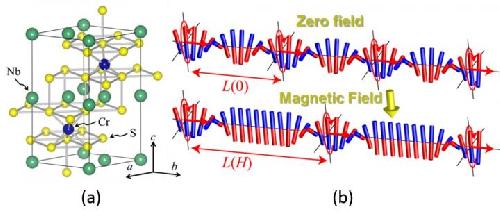Members of a research collaboration have succeeded in experimentally verifying the properties of crystals of chiral magnetic materials, which may lead to the development of new types of magnetic memories with unprecedented storage capacities. The collaboration "A Consortium to Exploit Spin Chirality in Advanced Materials" was established in 2015 between scientists in several countries including Japan, Russia, and the UK.
"It is a great success for our international consortium, as we achieved the result effectively by taking advantage of the organization that is composed of experts in various research fields," said Katsuya Inoue, the Japanese coordinator of the consortium and professor Hiroshima University's Graduate School of Science.
Magnetic materials with chiral crystalline structures, also known as chiral magnets (for example, CrNb3S6), show a unique magnetic twisting effect that is triggered by a weak external magnetic field. The material looks like it is composed of atomic-sized magnets arranged helically, as shown in the figure (b).

In December 2015, researchers experimentally showed that the winding number of the twists can be detected electrically, and controlled by changing the strength of the external magnetic field. They designed a tiny device about the size of a human cell from CrNb3S6, and observed that the electrical resistance takes a series of discrete values that changes stepwise with change in the external magnetic field strength.
It was also visually demonstrated by using electron microscopy that the change in the electrical resistance corresponds to the change in the twisting of the magnetic field in the material. Using the device, the researchers reported data of 20 discrete states and were successful in unambiguously detecting these states.
Conventional electronic devices used as components in current electronic appliances handle information as binary data represented by a combination of "0" and "1". In magnetic materials, these two states correspond to the orientations of the magnetic field, namely "up" and "down".
However, new devices made from chiral magnets handle information as combinations of multiple digits corresponding to the multiple twists formed in the chiral magnets.
Dr. Yoshihiko Togawa from Osaka Prefecture University, who is the leader of the research team, said, "For example, the capacity of a storage memory device composed of 10 such new element devices made from chiral magnets, each of which has 10 discrete states, will be 10,000,000,000, which is about 10 million times larger than that of a conventional magnetic storage memory with the same number of conventional element devices."
Further studies are ongoing with respect to both scientific and technological aspects of these findings that target future practical applications, such as multiple-valued magnetic memories, sensors or logic devices with high storage capacities owing to the unique characteristic features of this material.




Comments